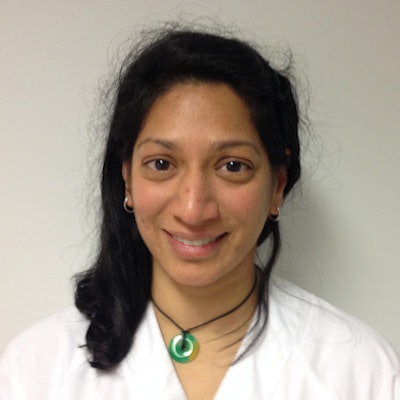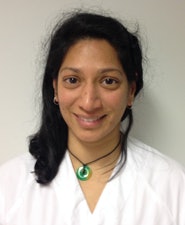
Since September 2017, responsibility for training in radiology and all other medical specialties switched to the regional health authorities in Norway. The country has four such authorities, organized geographically, and these health authorities, de facto the employers, must now educate and train new doctors.
 Dr. Anagha Parkar from Haraldsplass Diakonale Sykehus in Bergen, Norway.
Dr. Anagha Parkar from Haraldsplass Diakonale Sykehus in Bergen, Norway.The process has been delayed slightly, and the final format is not yet clear for many specialties, including radiology. So far, we know the length of training and the obligatory courses will remain the same, but the actual contents of "the log book" are unknown. This has raised questions about the future quality of training.
Traditionally, training and education is expensive, and it is always preferable for employers to see doctors work and do routine jobs, rather than allowing people to be merely "paid students." I cannot say, today, that the new system will be poorer, as we still have not heard about the final contents of training in radiology. Also, we don't know how trainees will be tested and how departments who do not fulfill the training requirements will be checked or penalized.
Today, we have a system where failing departments lose the right to train radiologists, which also means losing valuable workforce members and status. I look forward to the future of our specialty with mixed feelings.
The old system
For decades the Norwegian Medical Association was responsible for the training of medical specialists. In 2009, a change in the law led to moving the official responsibility to the National Directorate of Health.
One of the reasons for this change was it seemed wrong for doctors to approve themselves, and this in itself was a valid reason. But at the time it was perceived as a lack of faith in the previous system and it did cause a stir. It was a formal move, but the contents of the training were still determined by the Medical Association, while the follow-up was done by the Directorate.
Slowly we have accepted the new system and are getting used to it. There is a national standard now. The training requirements are the same for everyone across the country.
| The old vs. new training systems | ||
| Old system | New system | |
| Prior requirements before entering radiology training | 18 months residency (6 months surgery, internal medicine, and country practice, or 4 months surgery, internal medicine, psychiatry, and 6 months country practice) | Same requirements |
| Length of radiology training | 5 years minimum, but one year may be replaced by one clinical or research year | 5 years minimum, acceptance of clinical or research year unknown |
| Log book | Yes | Yes, but contents unknown |
| Obligatory courses | Yes | Unknown |
| System to secure proper training of radiologists | Yes | Unknown |
In radiology, the current requirement is a minimum of five years of training, where up to one year could be done in a related clinical field or research (in reality all other clinical fields except psychiatry and general practice). Eighteen months have to be spent in a larger department or a university hospital department. Furthermore, the candidate has to attend 10 national radiology courses, one course in administration, and one online course on how to perform expert (second) opinions.
Under the new system, we have returned to a situation where the ones delivering the training are the ones approving it. This is unfortunate. If the argument to remove training from the Medical Association was valid in 2009, how is it not valid in 2017?
Dr. Anagha Parkar is a radiologist at Haraldsplass Diakonale Sykehus in Bergen, Norway.
The comments and observations expressed herein do not necessarily reflect the opinions of AuntMinnieEurope.com, nor should they be construed as an endorsement or admonishment of any particular vendor, analyst, industry consultant, or consulting group.



















